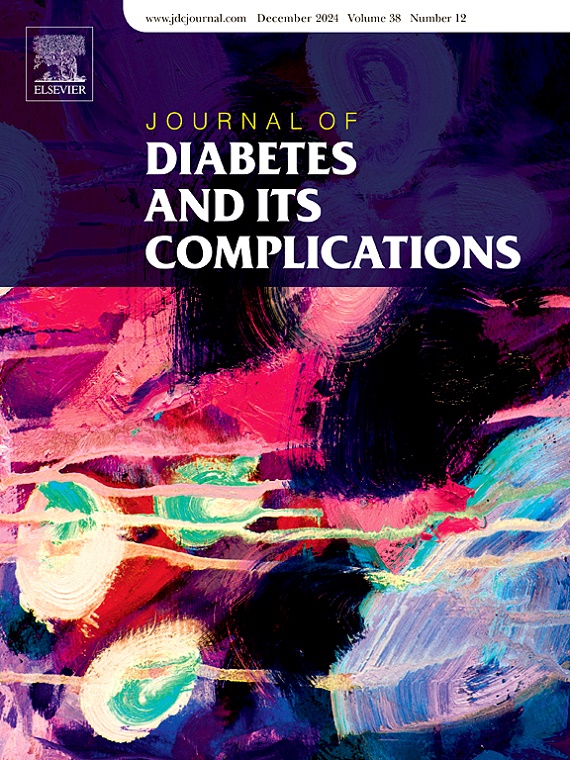Growth differentiation factor-15: A marker for diabetic kidney disease in patients with metabolic-associated fatty liver disease
IF 3.1
3区 医学
Q3 ENDOCRINOLOGY & METABOLISM
引用次数: 0
Abstract
Background
Growth/differentiation factor-15 (GDF-15) plays a crucial role in modulating inflammation and fibrosis and is emerging as a potential biomarker in metabolic diseases. This study investigated the association between circulating GDF-15 levels and the development of diabetic kidney disease (DKD) in patients with type 2 diabetes mellitus (T2DM), with or without metabolic dysfunction-associated fatty liver disease (MAFLD).
Methods
In this prospective observational study, participants were stratified into three groups: those with T2DM and MAFLD (Group A) and those with T2DM and no MAFLD (Group B), alongside a healthy control group (Group C). Comprehensive clinical evaluations and laboratory assessments, including measurements of GDF-15, metabolic profiles, liver enzymes, and renal function, were performed.
Results
GDF-15 levels demonstrated a stepwise elevation from controls to T2DM patients, with the highest levels observed in patients with MAFLD (1929 ± 412 pg/mL in Group A, 1655 ± 368 pg/mL in Group B, and 1246 ± 245 pg/mL in Group C; p < 0.001). DKD was diagnosed in 51.4 % of patients in Group A compared to 37.1 % in Group B (p < 0.001). Multivariate analysis identified GDF-15 as the sole independent predictor of DKD (p = 0.01). ROC curve analysis revealed that a GDF-15 cutoff value of ≥1890.51 pg/mL provided an AUC of 0.951, with a sensitivity of 94.2 % and specificity of 87.1 %.
Conclusion
Elevated GDF-15 levels are independently associated with an increased risk of DKD in T2DM patients, particularly in those with MAFLD. These findings highlight the potential of GDF-15 as an early biomarker for DKD.

生长分化因子-15:代谢相关性脂肪肝患者糖尿病肾病的标志物
生长/分化因子-15 (GDF-15)在调节炎症和纤维化中起着至关重要的作用,并正在成为代谢性疾病的潜在生物标志物。本研究探讨了伴有或不伴有代谢功能障碍相关脂肪性肝病(MAFLD)的2型糖尿病(T2DM)患者循环GDF-15水平与糖尿病肾病(DKD)发展之间的关系。在这项前瞻性观察性研究中,参与者被分为三组:T2DM合并MAFLD患者(A组)和T2DM合并MAFLD患者(B组),以及健康对照组(C组)。进行全面的临床和实验室评估,包括GDF-15、代谢谱、肝酶和肾功能的测量。结果:从对照组到T2DM患者,gdf -15水平逐步升高,其中MAFLD患者的gdf -15水平最高(a组1929±412 pg/mL, B组1655±368 pg/mL, C组1246±245 pg/mL);p & lt;0.001)。A组有51.4%的患者诊断为DKD,而B组为37.1% (p <;0.001)。多变量分析发现GDF-15是DKD的唯一独立预测因子(p = 0.01)。ROC曲线分析显示,GDF-15截断值≥1890.51 pg/mL时,AUC为0.951,灵敏度为94.2%,特异性为87.1%。结论:GDF-15水平升高与T2DM患者DKD风险增加独立相关,特别是在mld患者中。这些发现突出了GDF-15作为DKD早期生物标志物的潜力。
本文章由计算机程序翻译,如有差异,请以英文原文为准。
求助全文
约1分钟内获得全文
求助全文
来源期刊

Journal of diabetes and its complications
医学-内分泌学与代谢
CiteScore
5.90
自引率
3.30%
发文量
153
审稿时长
16 days
期刊介绍:
Journal of Diabetes and Its Complications (JDC) is a journal for health care practitioners and researchers, that publishes original research about the pathogenesis, diagnosis and management of diabetes mellitus and its complications. JDC also publishes articles on physiological and molecular aspects of glucose homeostasis.
The primary purpose of JDC is to act as a source of information usable by diabetes practitioners and researchers to increase their knowledge about mechanisms of diabetes and complications development, and promote better management of people with diabetes who are at risk for those complications.
Manuscripts submitted to JDC can report any aspect of basic, translational or clinical research as well as epidemiology. Topics can range broadly from early prediabetes to late-stage complicated diabetes. Topics relevant to basic/translational reports include pancreatic islet dysfunction and insulin resistance, altered adipose tissue function in diabetes, altered neuronal control of glucose homeostasis and mechanisms of drug action. Topics relevant to diabetic complications include diabetic retinopathy, neuropathy and nephropathy; peripheral vascular disease and coronary heart disease; gastrointestinal disorders, renal failure and impotence; and hypertension and hyperlipidemia.
 求助内容:
求助内容: 应助结果提醒方式:
应助结果提醒方式:


